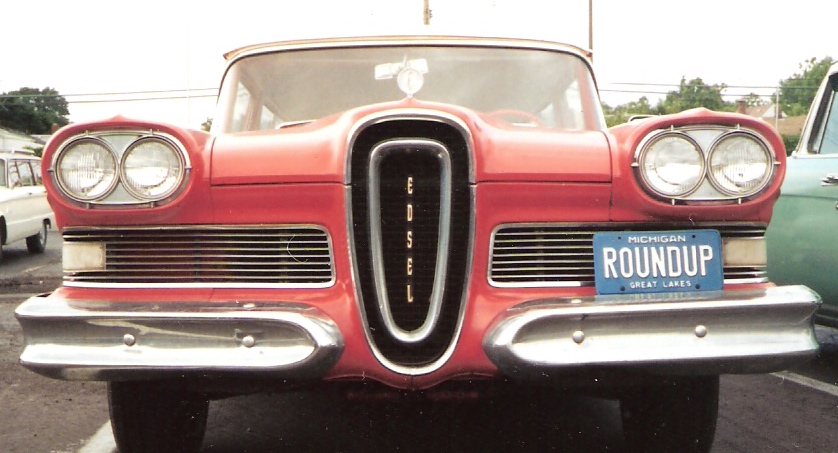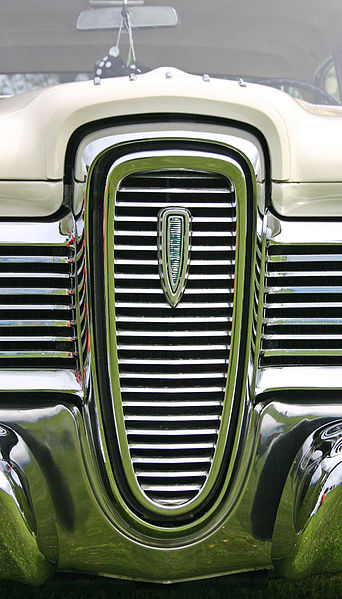Ford was able to command vast numbers of person-hours of labor but these creative efforts went entirely unmanifested in social good.
The Edsel, a car introduced by Ford in 1958, is famous in postwar American history as a costly failure. It sold poorly and its production was cancelled after little more than two years; it is written about even in the 21st Century as a cautionary case study. The Edsel fiasco has stimulated a large literature with abundant ironies, interesting personal and corporate stories, a few nice jokes (“Every Day Something Else Leaks”), and even some sober business reflections. All of these ignore some actually important points.
According to a number of histories and contemporary articles, the Edsel was conceived as a tool to wrest away from General Motors and Chrysler a significant portion of the so-called mid-price auto market. It was intended, in other words, to substitute the Edsel for cars already in production; already fulfilling the exact role for which the Edsel was designed.
It was not intended to provide an important addition to the transportation picture in America.
Thus the Edsel program was not intended to provide an important addition to the transportation picture in America, but to attempt to lessen the value of the physical and human investment already made in design, tooling, manufacture, and distribution of mid-price cars by scraping some of that market away with Ford’s own investment in the very same things.
All the preparations for full production were made at the engineering, design and organizational levels; thousands of dealerships were established; people’s lives were disrupted when they were hired into countless positions. But since the item of transportation and style represented by the Edsel already existed, with all these same socially-expensive preparations having been made more than once at GM and Chrysler, no real good could have come from the Edsel program.
Moreover, all these preparations having taken place in secrecy, there was no way to assess the actual prospects for success, taking into account the public acceptance of the styling, interior features, cost and such. Nor was there any way to predict the actual state of the economy, and the associated public “mood,” at the time of introduction.
The function of the styling was to influence buyers away from the competition.
The lead times for car design are cited as one of the reasons for the appearance of the Edsel at an inopportune moment. A large portion of the lead time, for all cars, was and is expended in numerous, even exhaustive iterations of styling concepts. These were all done in deepest secrecy of course. Since transportation is a fundamental need, which the public was going to purchase one way or another, the intended function of the styling was to influence buyers away from the competition.
From the Edsel histories it is clear that much design and engineering work actually constituted what is constantly referred to in engineering school as Reinvention Of The Wheel. Interior reworks, new but conventional engines, gadgetry such as the supposedly exciting transmission controls in the steering wheel hub, each of these occupied the efforts of countless skilled humans, the waste of whose time is only vaguely reflected in the famous monetary costs to Ford. Waste, that is, since perfectly adequate solutions to the real design and engineering challenges were already in existence.
Product competitive differentiation, or styling, in the automotive industry is expressed largely in the form of sheet metal. Just the effort required to determine how the car’s external shape, determined by the stylists, will be divided into various metal stampings, and ensuring that these all fit together correctly, is an enormous and time-consuming task that must be coordinated among a large group of engineers and technicians.
Then, the transformation of sheets of steel into auto shapes reflecting the final styling requires tooling of staggering size and complexity. The presses are huge pieces of capital equipment whose own design and fabrication is a major industry. The adaptation of these presses to smash steel into new car shapes requires the detailed design and fabrication of dies by skilled engineers and technicians.
Two totally new V-8 engines were designed and put into production for Edsel.
Two totally new V-8 engines were designed and put into production for Edsel. A Ford engineering paper describing the design of a similar engine in that era estimated that almost 600,000 person-hours were expended on that effort. That is, about 300 person-years. (See Society of Automotive Engineers paper 540266.)
All of these resources and human skills went to waste on the Edsel because of the pathetically brief period over which they were effectively amortized. But also of course because they would not have expressed their true, full value even had the car succeeded since they were redundant in a social sense, the niche having already been filled by other tooling, other cars.
This abbreviated discussion barely touches the list of tasks required, now as then, to bring a new car into production. Nor does it even mention the interesting and useful projects not done or not conceived because of the diversion of so much true talent into Ford’s bad dream.
It represented an American business entity functioning in a legal and accepted manner.
Whatever the reasons for the disaster of the Edsel program, it represented an American business entity functioning in a legal and accepted manner. This meant that Ford was able to command vast numbers of person-hours of labor, most of whose human providers were whipsawed by the rapid rise and fall of their employment situations, and whose creative efforts went entirely unmanifested in social good.
It meant that tons of iron ore and scarce alloying elements were fabricated with great expenditure of irreplaceable thermodynamic energy into tooling that died young. It meant, even, that many of those involved in the project would experience their rightful exhilaration of being involved in a large and exciting technical project turning to cynicism.
Capitalism — or if not capitalism, at least the form of economic activity prevalent in the United States — is founded on competition and the associated secrecy. “Associated,” because to reveal an item’s details during its development would forewarn and forearm other business entities. But the secrecy, so important in the Edsel saga, carries a social penalty that is never discussed; one that a person could go through an entire college curriculum and never encounter.
A well-adjusted society would see to it that the expenditures were worthwhile.
Resources, including the thing called “human resources” that is the accumulated ingenuity of generations, are expended in a development program and they are never recoverable. A well-adjusted society would see to it that the expenditures were worthwhile. In the existing form of social organization this waste and disruption is not problematic; it is part of the prerogative of a business entity.
In the contemporary Edsel literature and some of the recent writing, the discussions of secrecy and competition seem coy to the point of infantilism considering that mining machinery and blast furnaces and an army of workers would be activated to bring the program to fruition.
An alternative — anathema of course given the private interests to be satisfied — would be for automobile design and development to be conducted in public, in such a way as to vastly increase the probability that the resulting manufactured goods would meet with citizen approval and acceptance.
The Edsel is an example of a failed project. In conventional discussions, emphasis is placed on the monetary costs of the Edsel project to Ford, but these are trivial by comparison to the waste of physical resources and human creativity and to the opportunity costs incurred. The Edsel is a particularly massive failed project example; smaller ones abound, whenever a product is developed and introduced but does not sell up to expectations.
Computers, cell phones, laundry detergents, cars and their accessories, all kinds of products can and do fail. As in the Edsel case, if they were not developed in secrecy, but were openly designed in coordination with assessments of actual social needs, the incidence of failure would be lower. Naturally this cannot be when competition among business entities for market share is at stake.
[Henry Mecredy is a mechanical engineer from Austin and a Son of the Republic of Texas. As a child, he was influenced by a television program called Industry On Parade.]




















Great piece, Henry! So you.